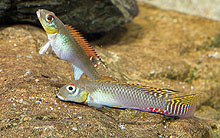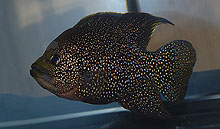WHAT'S NEW ACROSS THE WORLD
Select date in side bar to go to a What's New of previous issues
| What's New
©by Laif DeMason
Winter’s cold blast and heavy snow came late this year for most of the nation. Seems like this late winter onset has been the pattern over the last few years. Like they say when either extreme cold or heavy snow is forecasted, “best to stay home and don’t venture out”. What better time to care for and enjoy your fishy pets? You can review or rearrange your set up and maybe it is time to add a few more species…. When the weather breaks, don’t forget your local fish shop or fish club meeting!
Here’s “what’s new” on the cichlid scene: |
Lake Tanganyika
Looks like collection of wild material has been sparked lately by the increased interests of purchasing hobbyists. Most of the southern Congo and Zambia has been fuelled with activity. Tanzanian and Burundi exports are further trying to adjust to demands from buyers and competition by Far East breeders.
| WHAT'S NEW: LAKE TANGANYIKA |

Wild Tropheus are still king, but sales are now narrowed to only certain favorite types and locations infrequently collected. A recent collection of the so-called T. moorii Murago Green hit with some nice specimens. There are several “Murago” type fishes in nearby areas of Congo.
|

Another infrequently imported cichlid is Tropheus annectens from the Kitumba area. These appear to be somewhat more greenish compared to the Kekese, Tanzania, variety also recently imported. However it could be that these particular fish are just younger.
|

Many types and locations of featherfins can be usually collected, however, demand is only strong for wild Ophthalmotilapia in China. Several not often seen species have been imported again. Here O. ventralis from Zongwe, Congo, sporting unpaired and caudal-fin markings that become orange in charged-up males.
|

Exciting news, wild Kitumba Leptosoma have been collected and exported again recently. These new arrivals are now often sold as Cyprichromis “Speckleback” from both Kitumba and Tembwe, Congo, and arrive a bit larger than a typical Cyprichromis sp. ‘leptosoma jumbo’. Photo A. Konings.
|
Lake Malawi
Multitudes of bred Malawi cichlids are available from farmed sources for relatively cheaper prices, which make most of the wild-caught items “too expensive”…. Wild Malawi fish are still being collected and exported, but mostly rare or special species that are popular, such as OB mbuna, and these must be sourced from small specialty importers.

Many of the aggressive Petrotilapia species and local variants are still in demand from wild caught buyers. There are several different ones exported from time to time, especially into Europe. Here a recent import P. nigra type from Magunga Tanzania. Photo by A. Konings.
|

Many locations of Labeotropheus trewavasae are interesting because several varieties have OB females and sometimes OB males. Recently imported again, L. trewavasae “yellow head” from Pombo Reef, Tanzania. This marmalade cat male is one of the rarest fish in the lake.
|

Hailing from Nkhomo Reef, Malawi is an incidental “dwarf” import, Metriaclima sp. ‘lime nkhomo’. Typically this wild cichlid is no more than 2” (5 cm) in length! This is why Malawi hobbyists with small tanks want to keep them.
|

Where have all the red peacocks gone? Which is more red, German red or Rubin red? To me these names mean nothing in particular and really neither strain is exact. Actually the red Aulonocara was first developed in Holland.
|
West and Other Africa
| WHAT'S NEW: OTHER AFRICAN CICHLIDS |

A new diminutive species collected and exported from Kinshasa, Congo, is Nanochromis splendens. Often this fish arrives under 0.75” (19 mm) and rarely has any color. Time and growth will bring out the beauty in this fish. Photo by O. Lucanus.
|

Increasing in popularity recently, the small spot Paratilapia grows to a very large size. The first Paratilapia species to arrive in the USA via New York, it was called for a long time P. polleni, however, now that name seems to be incorrect. We should correctly call this fish “Small Spot Fony”.
|
Select date in side bar to go a What's New of previous issues |









